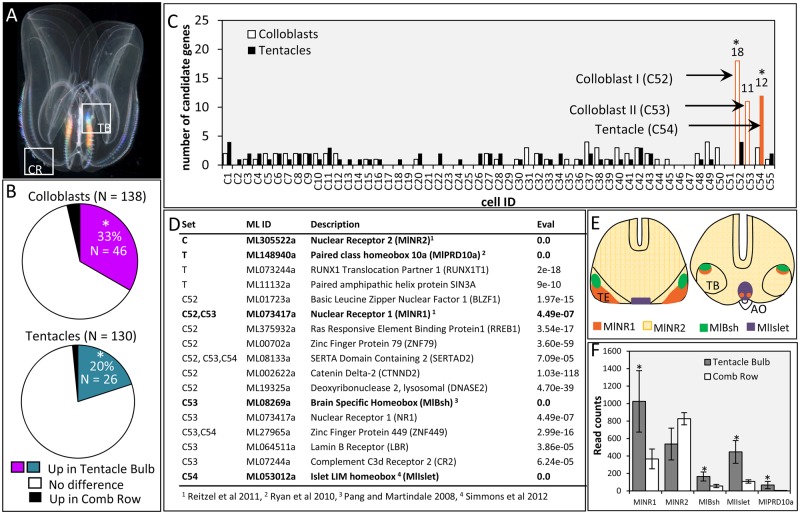Fig. 4.
Colloblast and tentacle candidates are expressed together in adult Mnemiopsis leidyi. (A) Tissue sampling protocol for tentacle bulb (TB) and comb row (CR) transcriptome sequencing. (B) Over 70% of the colloblast and tentacle candidate genes were expressed in adult tissues (N = 138/189 colloblast candidates, N = 130/165 tentacle candidates). In both data sets, a significant proportion of the expressed genes (P < 0.0001 for both colloblast and tentacle candidates) were upregulated in the tentacle bulb, relative to the comb row (≥2 log2-fold change, padj < 0.05). (C) There was a significant cluster of colloblast candidates in cell C52 (P < 0.0001), with a second cluster in cell C53. Tentacle candidates clustered significantly in cell C54 (P = 0.0015). Cell IDs refer to single-cell sequencing results reported in Sebe-Pedros, Chomsky, et al. (2018). (D) Seventeen transcription factors were identified from colloblast candidates (C), tentacle candidates (T), or cells C52, C53, or C54 using GO terms GO: 0003677, GO: 0003700, GO: 0006351, and GO: 0006355. E-values represent the reciprocal best BLAST hit in the human genome, except for genes already identified from M. leidyi (Eval = 0.0). Only significant hits (E ≤ 1e–03) are shown. Genes previously characterized by in situ hybridization are indicated in bold. (E) Summarized expression of MlNR1, MlNR2, MlBsh, and MlIslet in the presumptive tentacle epithelium (TE), the invaginated tentacle bulb (TB), and near the apical organ (AO) during embryonic development. (F) Read counts for previously characterized transcription factors in tissues from adult M. leidyi. MlNR1, MlBsh, MlIslet, and MlPRD10A are significantly upregulated (≥2 log2-fold change) in the tentacle bulb (MlNR1 P = 0.004, MlBsh P = 0.010, MlIslet P < 0.001, MlPRD10A P = 0.026). MlNR2 is not differentially expressed (P = 0.893).

